The Gibbes Museum of Art Honors Spike Lee
2024 honoree Spike Lee champions the vital role of Black artists in the American South during this crucial time in our culture, and warns about the dangers of AI for artists
Growing up, there were some truly profound filmmakers that opened our eyes to the reality of life, systemic injustice, power dynamics, and the importance of coming together through a collective identity of truth. One such filmmaker is Spike Lee, whose work has influenced me as a writer, an activist, and a filmmaker. With an incredible portfolio of films, it was Clockers that forever changed me. I am eternally grateful Spike Lee is in this world, sharing his vision, his work that has been instrumental in raising awareness and showing the very essence of humanity, and his brilliance for showing societal hierarchies and systemic wrongs in ways that break down institutional privilege into actionable response.

The Gibbes Museum of Art, a beacon in the American South since its establishment in 1858, honored Spike Lee at the Museum’s 2024 Distinguished Lecture Series annual event. The conversation at the Charleston Music Hall was filled to capacity, moderated by Pauline Forlenza, Director and CEO of the American Federation of Arts and co-presented with Angela Mack, President and CEO of the Gibbes Museum of Art. The conversation revealed new insights into the art world’s continued recognition of Spike Lee’s cultural impact. Lee’s legacy as a visionary icon worldwide is anchored by his longstanding commitment to authenticity and social justice. The Museum provided free live-streaming of the event for students from across the country, and is now making the video accessible to all viewers at this link, due to the timeliness of the discussion.
During his talk, Spike Lee championed the vital role of Black artists in the American South, especially during this crucial time for our culture. Lee highlighted artworks from his collection by African American southern artists that influenced his work, including: William H. Johnson (born in South Carolina); Romare Bearden (born in North Carolina); Deborah Roberts (Texas); Radcliffe Bailey (Georgia); and Michael Ray Charles (Louisiana). Lee discussed how these artists have always been creative sources of artistic expression for his film work, and for his ongoing creativity in arts and entertainment.
Academy Award-winning filmmaker, writer, producer, educator and art collector Spike Lee is a major influence on visual culture,” says Angela Mack, the Museum’s President and CEO.
His work spans four decades of artistic impact that has inspired generations. The Gibbes Museum of Art is thrilled to welcome Spike Lee to Charleston as our 2024 honoree.” The Museum’s series brings world-renowned artists, art collectors, museum leaders, philanthropists, and art historians to Charleston to stimulate public discussion about creativity and the visual arts. Previous honorees include: Jeff Koons, Fred Wilson, Maya Lin, Christo, Steve Locke, Dr. Sarah Elizabeth Lewis, Leonard A. Lauder, Jerry Saltz, Philippe de Montebello, and Martin Z. Margulies, among others.
During the conversation, Lee and Forlenza pointed out how many of the characters and themes from Lee’s films of the 1980s and 1990s foretold issues we are currently living through today, including: gentrification, global warming, and racial tensions. “History is repeating itself now,” says Spike Lee in the video of the lecture.
Looking back at these beloved characters, and the struggles they faced in these films, we can see how they forecasted back then (40 and 30 years ago), what’s happening now. The stuff you run away from follows you,” adds Lee.

During Lee’s presentation for the Gibbes Museum of Art Distinguished Lecture Series event at the Charleston Music Hall, Lee also spoke about the dangers of AI on arts and culture, social media, news, and the entertainment industry. “I think that sometimes technology can go too far,” said Lee. “I’m scared of what people can use AI to do and pass off as the real thing. Some of the things AI portrays people as saying is the opposite of what those people are all about. Especially with the Writers Guild trying to get the studios and networks to agree not to have these computers writing scripts,” adds Lee. “It’s scary, you don’t know what’s what.” When asked about his advice for young artists and filmmakers, including how art addresses current social issues, Lee said: “I tell my students they have to be committed and put the work in. Artists have to choose their own path. Artists have to do what their hearts and souls tell them to do.”
The Museum invited Pauline Forlenza, Director and CEO of the American Federation of Arts (AFA), to Charleston as guest moderator.
Spike Lee is an American treasure. His work brings to light bold storytelling and profound social commentary.” says Pauline Forlenza.
The AFA is a New York-based nonprofit that originated in 1906, with a mission to bring traveling exhibitions to communities that may not necessarily have access to art. For 118 years, the AFA has created initiatives to bring more diverse audiences into museums across the country and worldwide. “The Gibbes Museum’s rich history of spearheading art in America, as one of the country’s most longstanding cultural institutions, aligns with the mission of the American Federation of Arts,” adds Forlenza. “The Gibbes Museum has played a major role in expanding the community’s aesthetic and cultural lives, impacting the careers of American artists for more than a century.”
More About Spike Lee
Born in Atlanta in 1957 and raised in Brooklyn, Spike Lee graduated from Morehouse College (where he made his first student film, Last Hustle in Brooklyn). He also earned a Master of Fine Arts in film and television at New York University’s Tisch School of the Arts. Lee’s journey as a teacher began in 1991 when he was invited to teach a course at Harvard about filmmaking. He began to teach at New York University’s Tisch School of the Arts’ Graduate Film Program in 1993. Lee was appointed as artistic director of the School in 2002, and is now a tenured professor at NYU.
Lee has received five Academy Award nominations, winning the Oscar for Best Adapted Screenplay and an Honorary Academy Award for Lifetime Achievement. Other awards include: Primetime Emmy Awards, British Academy Film Awards, Peabody Award, Golden Globe Award nominations, Grammy Award nomination, the Board of Governor’s Award from the American Society of Cinematographers, a Gala Tribute from the Film Society of Lincoln Center, and the Dorothy and Lillian Gish Prize, among his many accolades.
He established his production company in Brooklyn in 1979, naming it 40 Acres and a Mule Filmworks as a nod to the promise of reparations to freed slaves. The company has produced all of Lee’s films, including the groundbreaking She’s Gotta Have It, Do the Right Thing, Malcolm X, and others. Lee’s influence transcends the film screen. His advancement of Black representation in media, and his confronting of social issues, continue to resonate globally. His advocacy for equality makes him a leading voice for generations, and for future artists and filmmakers. Lee was inducted on October 17, 2024 into the Naismith Memorial Basketball Hall of Fame’s James F. Goldstein SuperFan Gallery and is a 2024 National Civil Rights Museum Freedom Award Honoree.
About the Gibbes Museum of Art
The Gibbes Museum of Art, a beacon in the American South for arts and culture since 1858 when the Museum’s art collection was founded as the Carolina Art Association, is heralded as one of the earliest and most longstanding arts institutions in the United States. The Museum’s collection spans 350 years, and features some of the country’s most celebrated artists ‒ including contemporary, modern and historical works. With world-class rotating exhibitions and a dynamic visiting artist residency program, the Gibbes is a southern museum with a global perspective. The Museum’s mission is to enhance lives through art by engaging people of every background and experience with art and artists of enduring quality, providing opportunities to learn and discover, to enjoy and be inspired by the creative process. Museum hours and visitor info at: www.gibbesmuseum.org/visit








